Leatrice Joy plays a woman whose fiancé is more interested in unearthing 5,000-year-old mummies than in dating her. Instead of dumping the dude, she mopes and has historical flashbacks. So there.
I was made for either love or pasta. Possibly both.
It’s safe to say that Cecil B. DeMille’s career as a director really caught fire when he dove into the marital comedy racket. DeMille wasn’t the only director to use historical flashbacks to magnify the passions of modern lovers but he was one of the most adept at using them. Male and Female featured a real lion perched atop Gloria Swanson, Manslaughter included the sack of Rome and Adam’s Rib had the entire cast in fake fangs and skins as cavemen. Okay, so maybe the last one wasn’t so hot.
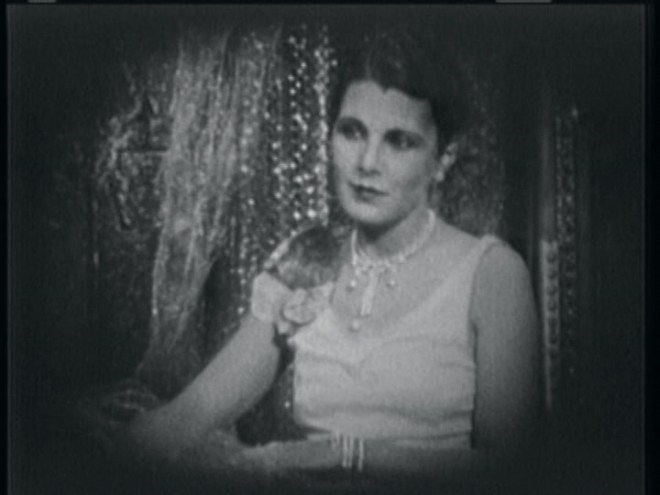
DeMile was just the producer of Made for Love but his fingerprints are all over the thing. It’s precisely the sort of bonkers blend of new and old that he adored and the relatively short runtime means that it doesn’t overstay its welcome. Further, it features the sparkling Leatrice Joy, one of the more underrated leading ladies of the silent screen. Joy had recently whacked off her hair and was wearing one of the most extreme of the 1920s hairdos. Critics couldn’t get enough of that hair or Joy’s performances.
Made for Love was released in February of 1926, just over three years after the November 1922 opening of King Tut’s tomb. It was also considerably influenced from the popular desert romance genre, which was not originated by The Sheik but was kicked into a cultural frenzy by it. (DeMille himself tried his hand at one of those pictures in 1915. Alas, The Arab is missing and presumed lost.) Finally, there are echoes of DeMille’s own recent hit The Ten Commandments, though the budget and sets are not nearly as grand. Still, they’re not shabby either.
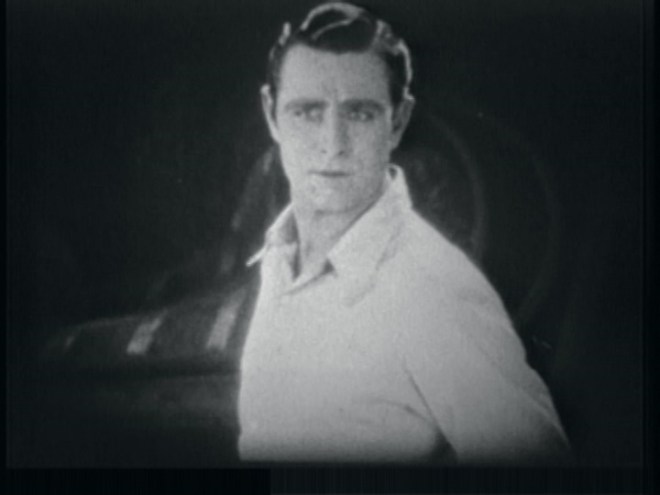
Nicholas Ainsworth (Edmund Burns) is an obsessed archaeologist who has discovered an ancient Lovers’ Tomb. It’s quite a find but his excitement has caused him to neglect his fiancée, Joan (Leatrice Joy), who is pretty chill about the Egyptology thing but would like to have dinner with her intended once in a while.
Prince Mahmoud Bey (Bertram Grassby) has been hanging around Joan with his smooth, Valentino-ish ways. Nicholas is jealous but not jealous enough to take his eyes off the tomb. Meanwhile, the Prince is helping himself to the treasures of the tombs via a secret passage. There are also three other suitors following Joan around but I can’t be bothered to remember them. (Pro tip: Don’t feature three characters when one or none could do the job.)
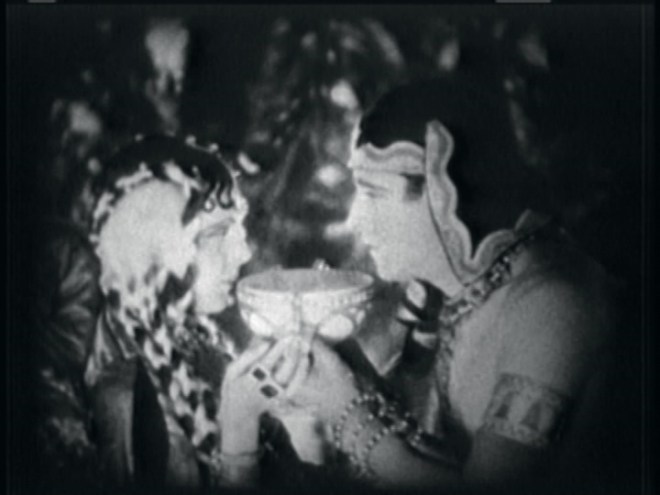
Then we get a flashback to ancient Egypt in which Joy and Burns play lovers who are poisoned by a jealous pharaoh (Brandon Hurst). The pharaoh then feels melancholy about their deaths and builds them a lovely tomb. Um, thanks for the tomb, pharaoh, but I’d rather just be allowed to live if it’s all the same to you. Oh, and there’s also a “curse of Isis” on anybody who disturbs the lovers.
Nicholas is acting like a whiney man-baby, ignoring Joan but growing petulant if she speaks to anybody else and throwing tantrums. He’s a real catch, that one. Joan moves out to a hotel and the Prince, who was the target of one of Nicholas’s outbursts, decides to revenge himself on the bratty archaeologist. He will wait until Nicky opens the Lovers’ Tomb and then bury him with dynamite. I fully support this idea.

Joan, on the other hand, does not. She still loves the little lunk. Will she be able to save Nicholas in time? Find out in Made for Love!
A quick note on some inconsistencies in the film’s credits and plot in the trade magazines. It’s not unusual for a silent film, especially one in the public domain, to be reissued with new names for the characters and minor revisions to the plot via cuts and title cards. This seems to be the case with Made for Love. Several characters have different names listed in trade publication reviews than what appear on the screen in the most readily available print. (I use the names found in the version I viewed in order to minimize confusion. All clippings courtesy of the Media History Digital Library.)
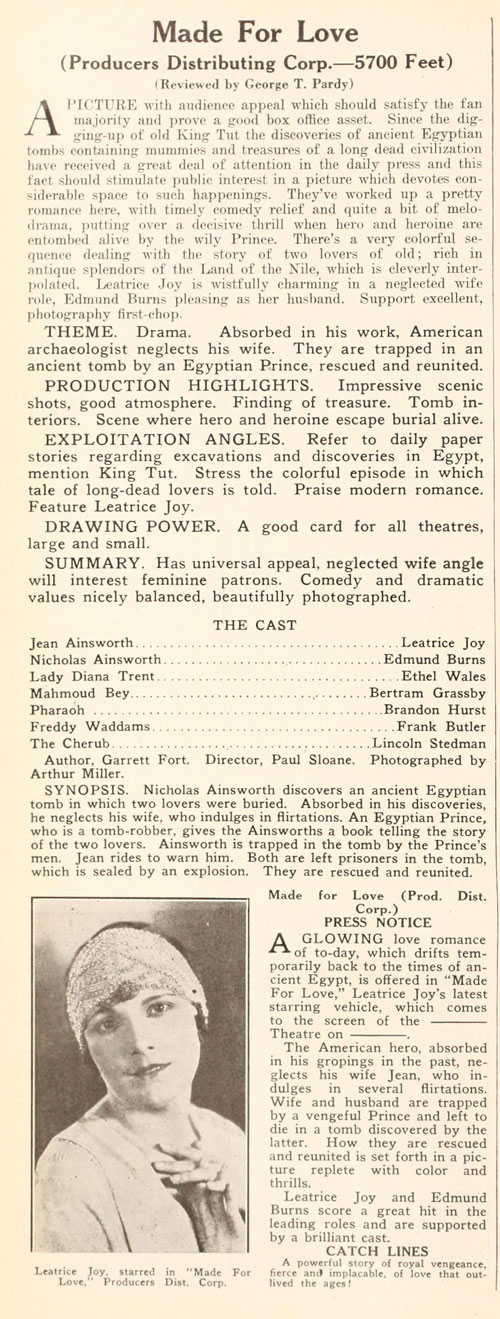

What is interesting is that (assuming this was not simply an error) Photoplay states that Leatrice Joy plays Edmund Burns’ fiancée and not his wife, as is stated in the trade publications. It could be that this change was introduced due to censorship concerns as implied cheating on one’s fiancé would not have been as sinful as implied cheating on one’s husband. But, as I said earlier, it may simply have been an error on the part of Photoplay’s review department. In any case, the wife-to-fiancée alteration is certainly present in available prints.
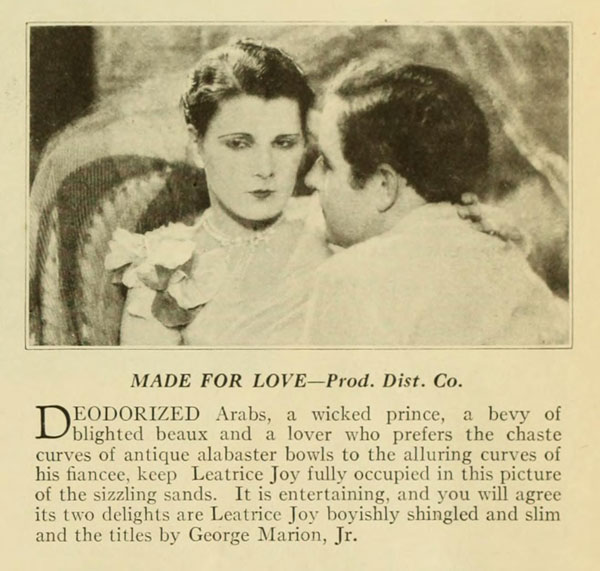
Unfortunately, this makes Joan’s motivation a bit less believable. A young 1920s wife whose husband dumps her for a hobby has our sympathy but if she is merely engaged to Nicholas, one wonders why she does not simply counter-dump the Egyptophile. “You love that cup so much? Marry IT!”
(By the way, this change in names and plot has led to a rather huffy entry in the film’s IMDB trivia section. As the AFI Catalog bases its information on trade periodicals, it uses the earlier names and plot descriptions for its entry on Made for Love. This seems to have struck a nerve somewhere.)
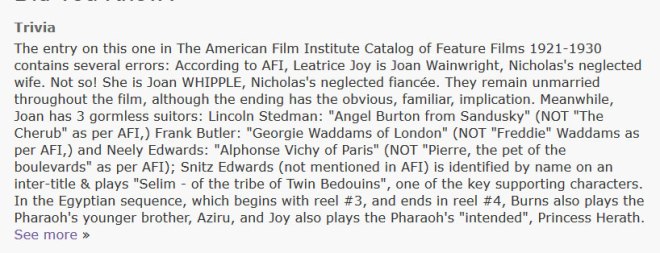
Despite good reviews, Made for Love only made back $162,000 of its $226,000 budget. In fact, of the entire first year program of DeMille Pictures, Inc., only one film broke even (The Wedding Song) and one actually turned a profit (Three Faces East). This was not due to poor films or obscure stars so much as the personality of the man signing the checks.
DeMille’s business was in trouble from the start as his lavish tastes applied not just to his own special productions but to the programmers as well. Program pictures were meant to be inexpensive genre fare that would pay the day-to-day bills. In DeMille’s studio, though, their budgets rivaled those C.B. had enjoyed at Paramount for his non-costume fare. There was simply no way for them to break even, especially without the Paramount distribution machine backing them.
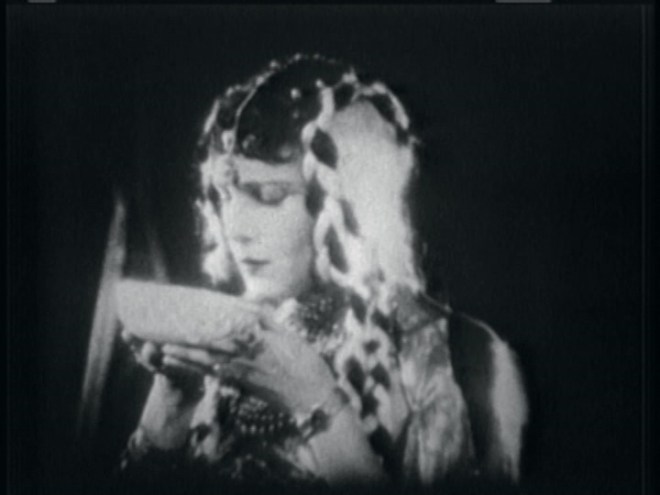
While DeMille’s books may have been a sea of red ink, his programmers provide special pleasures to the modern viewer. Put simply, DeMille programmers tended to be utterly daffy and, yes, that is a compliment. Left field plotting was the norm and while the films don’t always succeed, at least you know you’re seeing something totally different. Further, a good number of the films were scripted by women and/or featured assertive heroines with agency to spare.
Even better, a healthy percentage of DeMille’s programmers survive and are available on home video, which allows us to appreciate the full banquet of screwball plotting. Believe it or not, Made for Love is one of the more normal pictures the studio produced.
The title cards are particularly fun. My favorite:

And, of course, Leatrice Joy is a delight. Hands down, the best part of the film is when Joy suddenly transforms from neglected chick to action star. She pulls a gun on the baddie, locks him in his own houseboat and then shoves him off his horse when he tries to pursue her. Go, Leatrice, go! I wish she had done it sooner but I’m glad the scenes are present.
The supporting cast isn’t exactly up to Joy’s level but they’re okay. I’m not sure what the point of the three suitors was supposed to be. They’re not horrendously annoying as comedy relief goes but they do seem a bit redundant. Edmund Burns is okay but a bit on the dull side. Bertram Grassby is properly smoldering in his Valentino-esque part but the version of the film I saw never tells us what ends up happening to his character. I do so dislike loose ends. (Reviews state that the villain is killed by a falling rock. The end.)
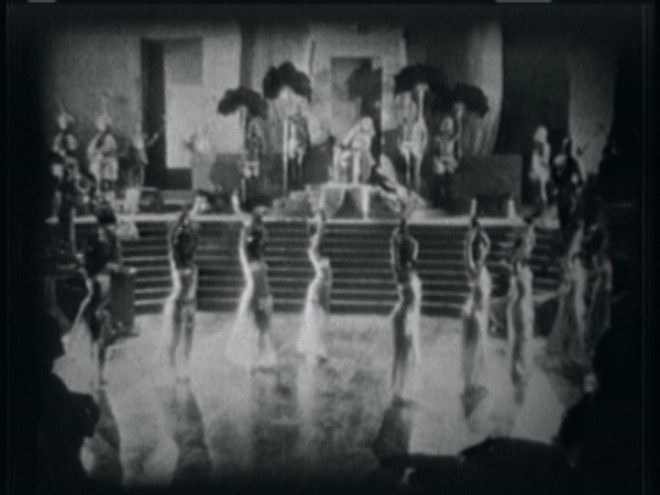
I would also be remiss if I did not mention that this picture is absolutely stunning. Sure, the sets aren’t as lavish as some of DeMille’s more famous pictures but for a programmer, they’re pretty darn sharp. And we get our picturesque boats and rivers and sunsets and sand dunes. I thoroughly approve. Paul Sloane, one of the DeMille company’s usual directors, does a good job of mimicking his boss’s style, even if he doesn’t quite have the same flair.
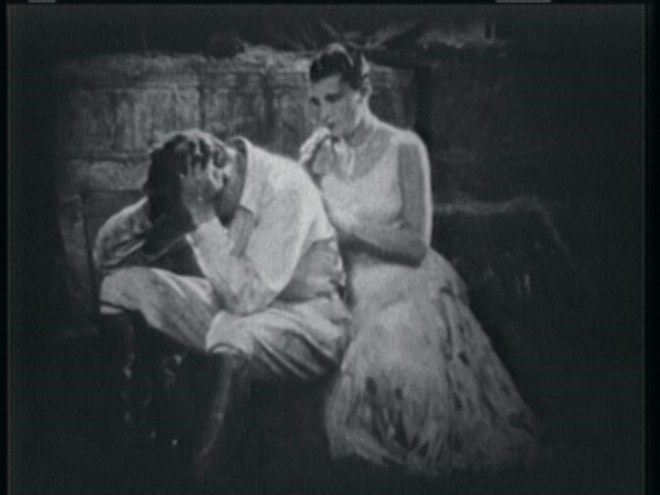
Made for Love is a kitschy blast, a picture that could only have been made in the 1920s. Leatrice Joy looks great and gives an appealing performance. She is absolutely the main draw for the picture, along with some pretty cinematography, costuming and set design. Just check your brain at the door, relax and enjoy the hokum. There’s plenty for everyone.
Where can I see it?
***
Like what you’re reading? Please consider sponsoring me on Patreon. All patrons will get early previews of upcoming features, exclusive polls and other goodies.

I bet YOU can answer this question: is it pronounced “Le-TREESE” or “LEE-uh-triss,” or something else?
I believe it simply rhymes with Beatrice. The story is that her mother was going to name her baby Beatrice but she remembered that her husband’s old flame had that name so she went through the alphabet until she found a letter that worked. “Aeatrice, Ceatrice, Deatrice, Eeatrice, Featrice…”
And when you say “Beatrice,” do you mean “buh-TREESE” or “BEE-uh-triss,” like in the ads for the giant company?
Just the standard American pronunciation. Here’s a video:
Thanks–I think I didn’t know that was considered the standard American pronunciation because my mom always pronounced the name of Ramona’s older sister the other way.
Lovely Leatrice strikes again, and what a gorgeous hair cut- love it! I’ve only seen Made for Love at a friend’s place and currently own no copy, but do I want to see it again now? You bet! Thanks for the great review and stills 🙂
Thank you so much! Yes, her hair is just divine, I think she and Vivien Oakland get the bravery award for their sharp styles.
Divine’s the word! Zelda Fitzgerald is another great style icon who went for this fabulously short cut in the mid-to-late 20s. I’d love to try it myself sometime, as it would provide a great excuse to wear more silk scarves and hats 😉
Never a bad thing 😀